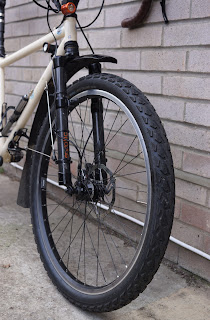Yes, I am borrowing from Robert M Pirsig’s “Zen and the art of motorcycle Maintenance”, which is a complex, yet engaging text about a middle-aged man and his son’s motorcycle trip together. They are accompanied by an adult couple, and it explores all sorts of deep questions via the journey interwoven with and reference to, motorcycle maintenance...
I digress...
They say things come in three. In this instance, cooked hub bearings, punctures and recurring Aheadset play with Ursula’s recently replaced Stronglight ST. A few possibilities sprung to mind. The most obvious that I mixed old and new crown races. Stripping confirmed I had in fact, put the old, worn race on the new fork. I’d cleaned the old race to inspect condition and must’ve placed it too close to the new one. I switched and then closer inspection suggested the Gusset head lock bolt was just a little short too.
Rummaging through the toolbox unearthed a slightly longer counterpart, so thread lock added. Everything snugged together nicely, and closer inspection revealed the crown race was old and quite well worn, given 8 years use. Used the remaining dregs of the Park Tool Polylube 1000 TESTED: PARK TOOL POLYLUBE 1000 LUBRICANT FOR BICYCLES (sevendaycyclist.com) on the replacement crown race and consigned the spent tube to the bin. Though annoying in some respects, the process of schematically working through, diagnosing and problem-solving is very cathartic. A means of decompressing, of calming the mind and working through other, unrelated things that are troubling me.
Punctures...Well, no sooner had I become comfortable with the Specialized Road Sport, I succumbed to a series of tube-claiming flats. One thorn had left a small but pronounced cut in the tyre casing (easily fixed with a drop of premium grade super glue). A flint and glass were the next to cause mischief. Cheap (rather than discounted) tubes are always false economy.
They’re OK as spares-getting you home, should you flat on the road/trail but very much contingencies. However, they’re often so thin, they’re bin fodder-patching is seldom reliable. Since we’re on the subject, decent patch kits are an equally sensible investment. I put my faith in the old-school feather-edged type. Glue-less types are too hit n’ miss for my tastes.
Leaving tubeless out of the equation, there are alternatives to butyl. Latex and TPU being two I’ve had middling experience with. Latex is noticeably light and relatively strong. However, they typically need inflating every other day and are relatively expensive. TPU, such as these Pirelli PIRELLI CENTURATO REINFORCED SMART TUBE (sevendaycyclist.com) are also relatively expensive but very lightweight and contribute to a compliant ride-palpably so, in my experience. Traditionally these weren’t repairable, but this is changing. As an aside, they’re a bit easier to fit too. Nonetheless, I’d still carry a spare butyl tube, since roadside repair isn’t practical in my experience (patches require a few hours curing time).
Sealant (typically latex) filled tubes are another option if you’re looking for some added puncture protection. These work by movement and pressure (loss) forcing the sealant to the hole. However, they also rely on the sharp being removed from the tyre casing too. Oh, and a blowout can be extremely messy.
That said; I tend to go the aftermarket sealant route with Schrader valves and on trailer/tagalongs. Thorn-resistant tubes are another option. These are the proverbial builder’s hose and hefty-460g for a 700x38 and made using 4.6mm butyl. However, I found them a blessing when Ursula, Joshua, and I were out on cold, bright winter rides-the last thing you want is a flat, 15 miles from home.
Talking of which, I typically carry a couple of spares-700c and 26inch- old but serviceable (think 3rd and final patch), in case someone is genuinely stuck by the roadside. Now, don’t get the wrong idea, I’m no “White Knight” or “Good Samaritan”. However, the spare can fail, ditto the pump- maybe you’ve run out of patches...These things can strike even the best prepared. I’d appreciate someone helping me in these situations-if they could.
Talking of life’s little frustrations seems that the second, successive consignment of maintenance sprays had been “lost in transit” by the courier. One so notorious for this, they recently had to rebrand...Thankfully, after perseverance and the manufacturer’s strong customer service, a new batch has just materialised. On a different note, I'll leave you with my review of the Kranx Strix 100 USB Rear Light that I've been referring to recently Kranx Strix 100 USB Rear Light | cycling-not-racing (sevendaycyclist.com)
















